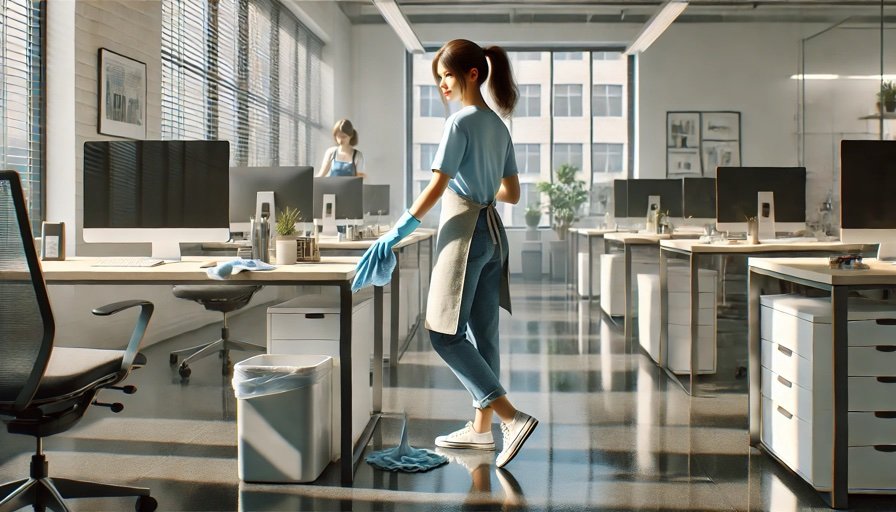How Often Should an Office Be Cleaned?
Having a clean office environment contributes a lot to the good health, productivity, and general workplace satisfaction of all employees. Nevertheless, very few know the best frequency of cleaning, as this is determined by several factors. In this broad-ranging guide, we shall discuss some principal considerations one would make in coming up with an efficient office cleaning schedule but also offer certain recommendations based on different kinds of offices and their size.
Factors to Consider in Choosing Office Cleaning Frequency
Among many other criteria, the following must be considered when determining how frequently an office should be cleaned:
1. Number of employees: Typically, the more employees an office has, the more frequently it needs to be cleaned because there will be more people coming in and out, causing a mess.
2. Office space: The larger the office, the more frequently it requires cleaning, especially when there are more people than available space.
3. Type of business: Certain industries, such as health and food, demand cleaner schedules for regulatory and sanitary reasons.
4. Customer volume: Offices with a high volume of visitors or clients would benefit from more frequent cleaning to make a good impression.
5. Office features: Carpeting is more common than hard-surface flooring in an office.
6. Hours of operation: Due to prolonged hours and multiple shifts, additional cleaning would be required to keep the office clean throughout the day.
Recommended Cleaning Frequencies
With these factors in mind, the following general guidelines for office cleaning frequencies are given below:
Daily Cleaning Tasks:
-Emptying of the trash bins
-Wiping down high touch points (doorknob, light switches, etc.)
-Restroom cleaning and sanitizing
-Vacuuming high-traffic areas
-Common area tidying
Weekly Cleaning Tasks:
-Thorough vacuuming or mopping of all floors
-Dusting all surfaces including desks, shelves, and equipment
-Window and mirror cleaning
-Kitchen sanitizing
Monthly or Quarterly Deep Cleaning:
-Carpet shampooing
-Deep cleaning upholstery
-Light fixture cleaning
-Sanitizing keyboards and other office equipment
Recommended Cleaning Frequencies
Based on these considerations, here are some general cleaning frequencies for the office:
The following tasks are recommended daily:
1. Emptying trash bins
2. Wipe high-touch surfaces—like doorknobs and light switches
3. Cleaning and sanitizing restrooms
4. Vacuuming high-traffic areas
5. Tidying common areas
Weekly Cleaning Tasks:
-Thorough vacuuming or mopping of all floors
-Dusting surfaces, including desks, shelves, and equipment
-Cleaning windows and mirrors
-Sanitizing kitchen areas
Monthly or Quarterly Deep Cleaning:
-Carpet shampooing
-Deep cleaning upholstery
-Cleaning light fixtures
-Sanitizing keyboards and other office equipment
Cleaning Frequency Guidelines by Office Type
1. Small Office (less than 20 employees): Regular cleaning: 2-3 times per week
2. Medium Offices (20-40 employees): Regular cleaning: 3-5 times per week
3. Large Offices (40+ employees): Regular cleaning: Daily
4. High-Traffic Areas: Daily cleaning and touch-ups throughout the day
5. Specialized Facilities: Multiple cleanings per day; follows industry-specific guidelines (healthcare, food service)
Importance of Regular Cleaning
Regular cleaning serves many purposes.
1. Health and Safety: Keeping a cleaning schedule maintains the cleanliness of a workplace by reducing germs and bacteria, which may help in reducing employee sick days.
2. Productivity: Minimal chances of having distracted moments and a more productive place to work—clean workspace.
3. Professional Image: An attractive, well-maintained, and pleasingly decorated office is also clean. This will help set a positive impression on clients visiting your premises.
4. Satisfaction of Employees: Workers are inspired to work in a clean working environment, thus increasing their morale and job satisfaction.
5. Long-term Savings by Delay: This kind of well-maintained office environment will stretch the life of furniture and equipment, thereby reducing its long-term cost of replacement.
Plan an Effective Cleaning Schedule
Follow these steps to help maintain your office at this level of cleanliness:
1. Cleaning schedule: Design a cleaning calendar around the daily, weekly, and monthly responsibilities.
2. Outsource to Professionals: Hire a professional cleaning agency or freelance cleaners who specialize in office cleaning.
3. Employee Participation: Design policies that will ensure employees clean their workstations.
4. Cleaning Products: Engage in environmentally friendly but effective cleaning products.
5. Regular Assessment: Periodically go back to the standards you set regarding cleaning in your office, and with that information, revise your cleaning schedule as appropriate.
That said, the frequency can be a case-specific affair and vary from one business to another in terms of office cleaning, similar to how Apartment Cleaning Seattle services schedule themselves according to different residential needs. Still, regular cleaning is always useful in handling all sorts of workplace issues regarding health, productivity, and professionalism. Knowing the size of your workspace, the nature of your business, and the demands of your employees can all be taken into account while developing a plan to keep the workspace in top condition year-round, much like Apartment Cleaning Seattle experts who take an assessment of individual living spaces and develop personalized cleaning plans. Using the adaptable approach as Apartment Cleaning Seattle, you can ensure a clean, healthy, and productive workspace in your working environment.
